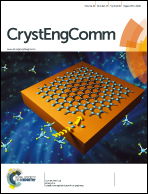Seven dicarboxylate-based coordination polymers with structural varieties and different solvent resistance properties derived from the introduction of small organic linkers†
Abstract
Seven new coordination polymers (CPs), namely, {[Co3(sdba)3·2H2O·DMF]·2DMF}n (1), {[Co2(sdba)·(μ3-OH)·(trz)·H2O]·H2O}n (2), {[Co2(sdba)·(μ3-OH)·(atz)·H2O]·H2O}n (3), {[Co(sdba)·(ti)2·H2O]·1.5H2O}n (4), {[Cu(sdba)·H2O]·1.5H2O}n (5), {[Cu2(sdba)·(μ3-OH)·(trz)·H2O]·H2O}n (6) and {[Zn2(sdba)·(atz)2]·0.5H2O}n (7) (H2sdba = 4,4′-sulfonyldibenzoic acid, Htrz = 1H-1,2,4-triazole, Hatz = 1H-1,2,4-triazol-3-amine, Hti = 4-(1H-benzo[d]imidazol-2-yl)thiazole), have been solvothermally synthesized and characterized by IR spectroscopy, elemental analysis and X-ray single-crystal diffraction. Complex 1 displays a 6-connected three-dimensional (3D) framework with {412·63} pcu topology, which consists of two-dimensional (2D) zigzag sheets connected in an alternate fashion. Complexes 2, 3 and 6 are isostructural, exhibiting an 8-connected “onion” 3D framework with the first reported {36·410·56·66} whc1 topology. Complex 4 exhibits a one-dimensional (1D) helix chain, which is further connected by hydrogen bonds, giving a 2D supramolecular framework. Complex 5 reveals a 1D ∞-like chain. Compound 7 is a 3D metal–organic framework, which shows a tetranodal 3,3,4,4-c net with the point symbol {46·82·1012}{46·83·10}{46·8}{48·2} named whc2 topology. The solvent resistance properties of 1–7 have been investigated in detail. This demonstrates that with the introduction of rigid organic molecules (Htrz, Hatz, and Hti) as auxiliary ligands, complexes 2–4, 6 and 7 show remarkable hydrothermal stability and boiling organic solvent resistance. More importantly, an alternative strategy for the rational assembly of CPs with both good solvent resistance and intriguing structural topologies has been proposed. In addition, the luminescent properties of complexes 2, 6 and 7 are discussed, and the thermal stabilities of complexes 2 and 7 are also investigated.


 Please wait while we load your content...
Please wait while we load your content...